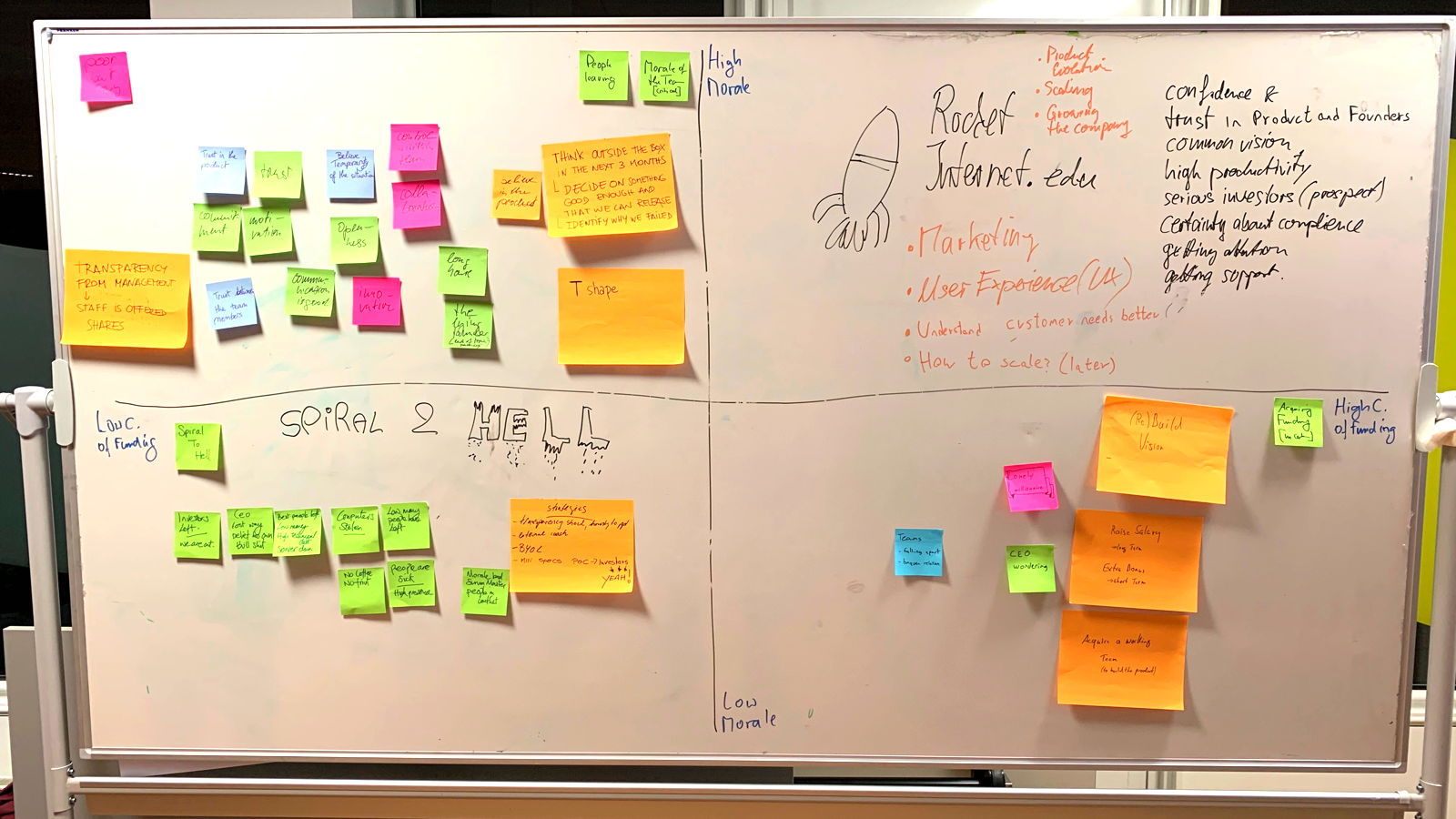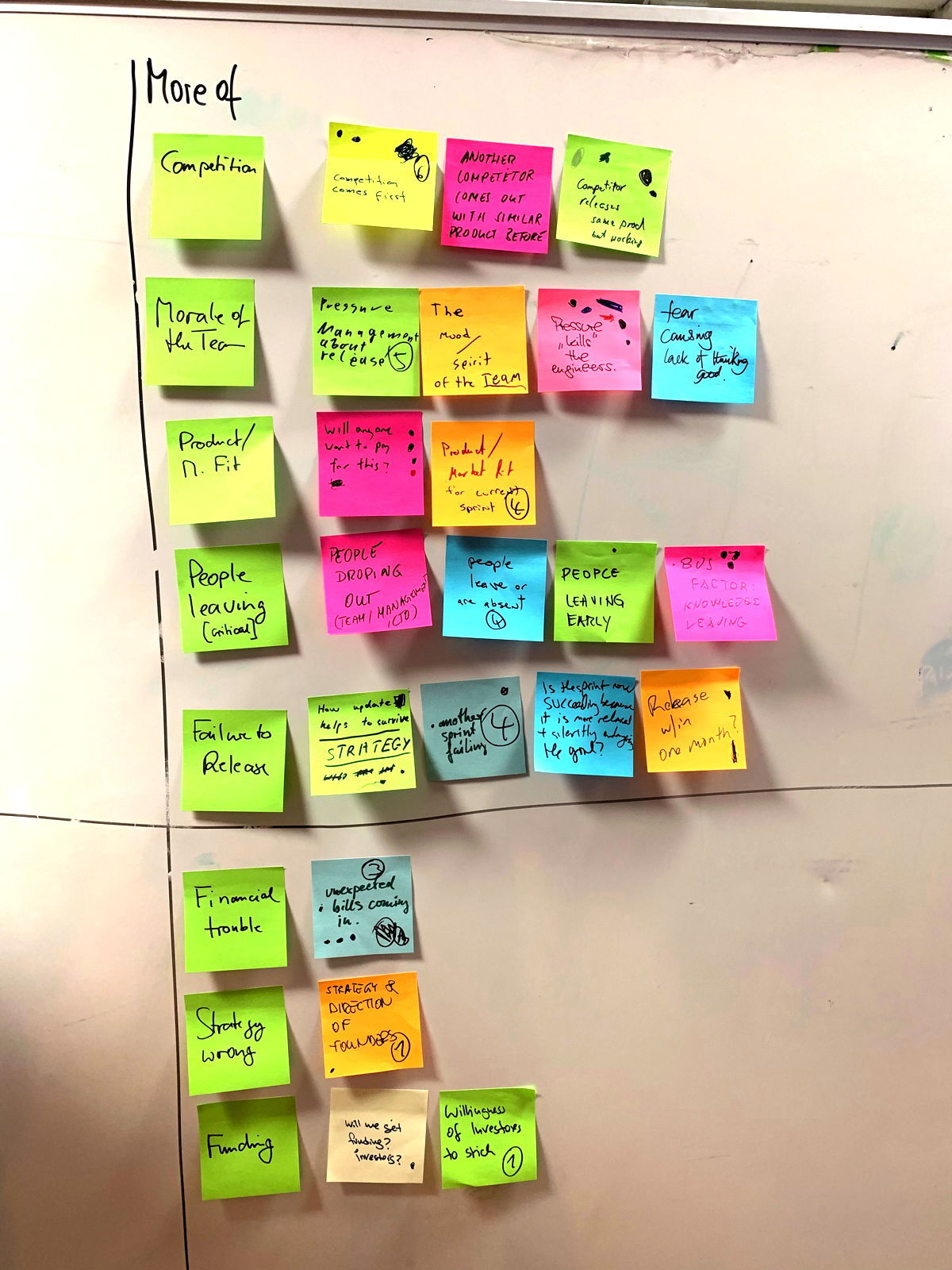Liberating Structures for Scrum (5): Strategy

TL; DR: The Liberating Structures Strategy Meetup
During this Liberating Structures strategy for Scrum meetup we addressed dealing with uncertainty — a particularly useful skill in highly competitive markets. Learn more about how to train and grow the resilience of your team when dealing with the unexpected.

Liberating Structures for Scrum
Created by Keith McCandless and Henri Lipmanowicz, Liberating Structures cover a set of easy to learn, yet powerful ways to collaborate as a team—even as a (very) large team by Scrum standards—, overcoming traditional communications approaches like presentations, managed discussions, or another disorganized brainstorming at which the loudest participants tend to prevail.
Generally, Liberating Structures are well suited to improve the level of engagement among participants of Scrum events, thus stimulating the kind of outcomes that are necessary to create learning organizations. Liberating Structures also provide an excellent toolbox to handle Product Backlog refinements or improving the Definition of Done of an engineering organization.
Lastly, Liberating Structures are a great tool when Scrum Teams come together for figuring out where to go next, particularly in highly competitive markets where nimble startups are everywhere.
Liberating Structures Strategy — Critical Uncertainties
To learn how to deal with uncertainty, we chose one of the advanced Liberating Structures microstructures — Critical Uncertainties:
What is made possible? You can help a diverse group quickly test the viability of current strategies and build its capacity to respond quickly to future challenges. This Liberating Structure prepares a group for strategy making. It does not produce a plan to be implemented as designed but rather builds resilience: the capacity to actively shape the system and be prepared to respond to surprise. This means being better able to see different futures unfolding, better prepared to act in a distributed fashion, and more ready to absorb disruptions resiliently. (Source.)
Regarding Berlin’s volatile startup scene and the resulting continuous pressure for Scrum teams to outperform expectations of stakeholders, the microstructure seemed particularly well-suited for an exploration.
Everyone is a String Designer. Normally.
Usually, the Hands-on Agile meetups addressing Liberating Structures for Scrum are not created by a design team in advance as there is no standard string that we explore or follow. Designing a Liberating Structures Daily Scrum string is a task for every participant. Not so this time, however, as the microstructure we chose to explore — Critical Uncertainties — requires too much time for a 2-hours evening event. So, this time, we skipped the string design part and focused on understanding the microstructure in depth.
Cannot see the form?
Please click here
The MegaBrain.io Scenario
Given the vastly different background of the attendees of a meetup, we use once again a prepared narrative — the MegaBrain.io scenario — as common ground to practice Liberating Structures’ Critical Uncertainties microstructure. A previous attempt based on climate change did not work well, as the topic turned out to be too broad, resulting in a wildly diverging list of factors.
Back to the MegaBrain.io scenario:
A year ago, MegaBrain.io was a well-funded, Berlin-based hopeful in the race to improve schooling by creating tailored curricula for each student derived from an AI.
Today, MegaBrain.io’s situation is dire:
- Only three months of runway left.
- In a last-ditch effort, the management fired 32 people mainly from marketing, sales, and administration last week to save liquidity to bring this new investor onboard—that was a third of the team.
- Conflicts among the founders, as well as between Product and Engineering, become more frequent as well as more public.
- The existing VCs are not pleased with the growth metrics for the last nine months and hence are reluctant to provide more capital to MegaBrain.io.
- However, there is a newly formed VC interested in investing—provided MegaBrain.io delivers the much anticipated yet overdue 3.0 release.
- The previous Sprint was a disaster. For the third time in a row, MegaBrain.io’s three Scrum Teams failed to deliver the 3.0 release.
- The current Sprint—ending in a week from now—looks more promising.
- All hopes now rest on the upcoming two Sprints to finally deliver the 3.0 release and to make the miracle of a new investment happen.
- The pressure on Engineering to deliver 3.0 is mounting at the same time, in any case.
- Some of the senior developers feel miserable about the mounting pressure from the management. Same of them have started answering calls from headhunters.
- Morale in the Scrum Teams is nearing an all-time low. The rate of people calling in sick is rising.
Liberating Structures Strategy: How to Practice Critical Uncertainties
We practiced Critical Uncertainties according to the manual:
- Invite attendees to make a list of uncertainties Megabrain.io faces by asking, “What factors are impossible to predict or to control their direction?” [Use 1-2-4-All.] ⏰ 10 minutes.
- Prioritize the most critical factors by asking, “Which factors threaten MegaBrain.io’s ability to operate successfully?” [Use dot-voting.] ⏰ 10 minutes.
- Select the most critical and the most uncertain factor (X and Y). ⏰ 5 minutes.
- Create a grid with two axes—X & Y—with a “more of <— —> less of” continuum for the factor to be represented on each axis. Repeat for the Y factor and axis, thus creating four quadrants. ⏰ 5 minutes.
- Create four groups. Each of the four groups creatively names and writes a thumbnail scenario for one of the quadrants. ⏰ 10 minutes.
- The four groups share their scenarios briefly. ⏰ 2 minutes each.
- Each group brainstorms three strategies that would help the group operate successfully in the scenario that it has described. ⏰ 10 minutes.
- The four groups share their strategies briefly. ⏰ 2 minutes each.
- The whole group sifts results to identify which strategies are:
- Robust (strategies that can succeed in multiple quadrants) and which are
- Hedging (strategies that can succeed in only one scenario but protect you from a plausible calamity). ⏰ 10 minutes.
Given that about 30 people attended the Liberating Structures strategy meetup, creating four working groups to address each quadrant was no challenge.
Results of the Liberating Structures Strategy Meetup
The first result of the evening was a list of factors that would threaten MegaBrain.io’s ability to operate successfully. We clustered the results, dot-voted and then chose the two factors that would provide the axes: a) the certainty of acquiring new funding and b) team morale.

The next step was forming four teams and creating three or more strategies for each of the quadrants. The groups identified the following scenarios:
- High morale/low certainty of a new funding. (“Poor, but sexy.”)
- Low morale/low certainty of a new funding. (“Spiral to hell.”)
- Low morale/high certainty of a new funding. (“Lonely millionaire.”)
- High morale/high certainty of a new funding. (“RocketInternet.edu.”)

In the end, we did not manage to identify a single robust strategy for MegaBrain.io. However, there was a consensus among the participants that Liberating Structures’ Critical Uncertainties is a well-suited exercise to prepare an organization to deal with uncertainty as well as for inspection and adaptation of existing strategies.
Conclusion
Liberating Structures proved again to be an exceptionally useful tool to facilitate inclusive events that tackle significant challenges, such as dealing with uncertainty. The sooner you start this process, the less likely your organization will follow in the footsteps of MegaBrain.io.
Have you used Liberating Structures to facilitate building resilience? If so, please share your findings with us in the comments.
Attribution
Liberating Structures are developed by Henri Lipmanowicz and Keith McCandless and are licensed under a Creative Commons Attribution-NonCommercial 4.0 International License.
Liberating Structures Strategy for Scrum — Related Content
📅 🎓 Berlin, February 18-20, 2020: Professional Scrum Training plus Liberating Structures — three immersive Days for Scrum Masters .
Liberating Structures for Scrum (1): The Sprint Retrospective.
Liberating Structures for Scrum (2): The Sprint Planning.
Liberating Structures for Scrum (3): The Product Backlog.
Liberating Structures for Scrum (4): The Daily Scrum
📅 Scrum Training Classes, Workshops, and Events
You can secure your seat for Scrum training classes, workshops, and meetups directly by following the corresponding link in the table below:
See all upcoming classes here.

You can book your seat for the training directly by following the corresponding links to the ticket shop. If the procurement process of your organization requires a different purchasing process, please contact Berlin Product People GmbH directly.
Tags: Daily Scrum, Liberating Structures, Strategy
